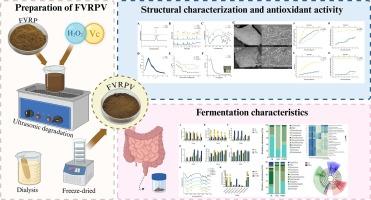用超声波辅助 H2O2-Vc 技术降解的绒毛虫残渣多糖的结构特征、抗氧化活性和发酵特性。
IF 8.7
1区 化学
Q1 ACOUSTICS
引用次数: 0
摘要
秉承低碳环保、变废为宝的理念,从绒毛虫残体多糖(FVRP)中开发出了具有抗氧化、降血糖、缓解重金属损伤等多种生物活性的多糖,但仍存在分子量高、生物利用度低等缺点。本研究首次采用超声波辅助 H2O2-Vc 技术从 FVRP 中制备降解多糖(FVRPV),以降低其分子量,从而提高其活性和生物利用度。我们的研究结果发现,FVRPV 的分子量和平均粒径均有所下降,但其单糖组成和特征官能团类型没有受到影响。通过 XRD、刚果红试验、I2-KI、扫描电镜和甲基化分析等方法对多糖的结构变化进行了分析,结果表明 FVRPV 的表面形态和糖苷键组成具有较长的侧链和较多的分支,晶体结构为无定形,无三重螺旋构型,经超声波辅助 H2O2-Vc 处理后发生了明显的变化。同时,与 FVRP 相比,FVRPV 的体外抗氧化能力明显提高,这表明超声辅助 H2O2-Vc 技术可能是提高多糖生物活性的有效方法。此外,FVRPV 中的多糖、还原糖和尿酸含量明显降低,但体外人粪便发酵液的抗氧化能力更强。16S rDNA 测序数据显示,FVRPV 可通过肠道微生物群介导的不同代谢途径富集益生菌并降低病原菌的丰度,从而发挥其潜在的益生作用。这项有趣的工作通过超声波辅助 H2O2-Vc 技术提供了一种新型降解多糖,为开发 FVRPV 作为新型抗氧化剂和益生元奠定了基础。本文章由计算机程序翻译,如有差异,请以英文原文为准。

Structural characterization, antioxidant activity, and fermentation characteristics of Flammulina velutipes residue polysaccharide degraded by ultrasonic assisted H2O2-Vc technique
Adhere to the concept of low-carbon environmental protection and turning waste into treasure, polysaccharides from Flammulina velutipes residue polysaccharide (FVRP) has been developed and possesses diverse bioactivities, comprising antioxidant, hypoglycemic, and relieving heavy metal damage, which still has the disadvantages of high molecular weight and low bioavailability. The current work is the first to prepare a degraded polysaccharide (FVRPV) from FVRP by ultrasonic assisted H2O2-Vc technique in order to reduce its molecular weight, thereby improving its activity and bioavailability. Our results found that the molecular weight and average particle size were declined, but the monosaccharide composition and characteristic functional group types of FVRPV had no impact. The structural changes of polysaccharides analyzed by XRD, Congo Red test, I2-KI, SEM, and methylation analysis indicated that the surface morphology and glycosidic bond composition of FVRPV possessed longer side chains and a greater number of branches with an amorphous crystal structure devoid of a triple helix configuration, and had experienced notable alterations after ultrasonic assisted H2O2-Vc treatment. Meanwhile, the in vitro antioxidant capacity of FVRPV had significantly increased compared to FVRP, implying ultrasonic assisted H2O2-Vc technique maybe a effective method to enhance the bioactivity of polysaccharides. In addition, the content of polysaccharide, reducing sugar, and uronic acid in FVRPV was significantly decreased, but antioxidant capacity of fermentation broth was stronger by in vitro human fecal fermentation. The 16S rDNA sequencing data displayed that FVRPV can enrich probiotics and reduce the abundance of pathogenic bacteria through different metabolic pathways mediated by gut microbiota, thereby exerting its potential probiotic effects. The interesting work provides a novel degraded polysaccharide by ultrasonic assisted H2O2-Vc technique, laying a foundation for developing FVRPV as a new antioxidant and prebiotic.
求助全文
通过发布文献求助,成功后即可免费获取论文全文。
去求助
来源期刊

Ultrasonics Sonochemistry
化学-化学综合
CiteScore
15.80
自引率
11.90%
发文量
361
审稿时长
59 days
期刊介绍:
Ultrasonics Sonochemistry stands as a premier international journal dedicated to the publication of high-quality research articles primarily focusing on chemical reactions and reactors induced by ultrasonic waves, known as sonochemistry. Beyond chemical reactions, the journal also welcomes contributions related to cavitation-induced events and processing, including sonoluminescence, and the transformation of materials on chemical, physical, and biological levels.
Since its inception in 1994, Ultrasonics Sonochemistry has consistently maintained a top ranking in the "Acoustics" category, reflecting its esteemed reputation in the field. The journal publishes exceptional papers covering various areas of ultrasonics and sonochemistry. Its contributions are highly regarded by both academia and industry stakeholders, demonstrating its relevance and impact in advancing research and innovation.
 求助内容:
求助内容: 应助结果提醒方式:
应助结果提醒方式:


